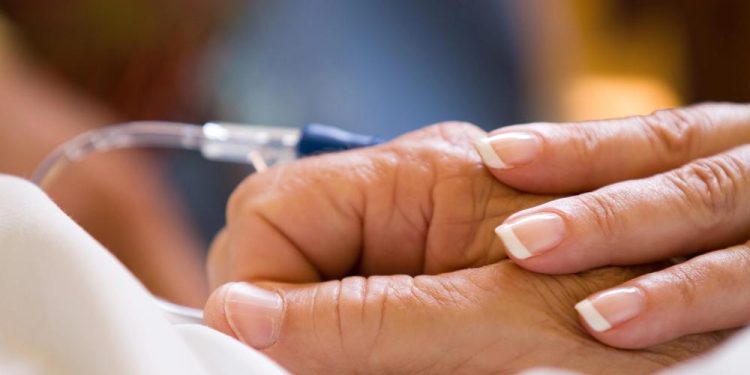Cancer cells can spread to other parts of the body, where they may cause new cancers. This is called recurrent cancer.
These cancers are rare. But anyone with a bile duct cancer risk factor should talk to their doctor.
A GP can feel your tummy for lumps or other problems. They may also ask for blood tests or imaging tests.
Diagnosis
Some people are diagnosed after they become unwell and go to A&E, but others start by seeing their GP. The GP might refer them for tests to check for cancer or other problems.
Procedures that make pictures of your internal tissues help diagnose bile duct cancer (cholangiocarcinoma). They can also show how far the cancer has spread. These include:
X-rays and CT scans — medical imaging tests that use X-rays or a computer to make detailed pictures of the inside of your body. An X-ray can detect a blockage in a bile duct, but a CT scan is usually needed to confirm it. You might have a cholangiogram, a special X-ray test that shows the bile ducts and any tumors in more detail. MRI scans can also provide valuable information about bile duct cancer and the area around it. A magnetic resonance cholangiopancreatography (MRCP) scan uses a magnet and radio waves to produce images of your liver, gallbladder and bile ducts.
Doctors can also test your blood for certain chemicals that may be high if you have bile duct cancer. These include carcinoembryonic antigen (CEA) and CA 19-9 tumor markers. These are released into the blood by organs or cells that are growing abnormally.
Your doctor might also do an endoscopic retrograde cholangiopancreatography (ERCP) to look at your bile ducts and pancreas more closely. This involves putting a long, flexible tube (an endoscope) down your throat and into your stomach or small intestine. It has a camera and light at the end, so your doctor can see and take samples (biopsies) of any lumps or areas that look suspicious. You might have an injection of medicine to make you drowsy before this procedure.
Other tests might be done to check how well your liver is working. These might include checking the levels of bilirubin and alkaline phosphatase in your blood. Your doctor might also do a genetic test to find out whether you have mutations in certain genes that increase your risk of bile duct cancer.
The outlook (prognosis) for bile duct cancer depends on how far it has spread when diagnosed and what type of cell it is. It also depends on your general health and how you manage your symptoms.
Treatment
The treatment options for bile duct cancer depend on the stage of the tumor, which means how far it has spread. The staging system divides bile duct cancer into three parts: the size of the tumor (T), how many lymph nodes it has spread to (N) and whether or not it has spread to distant organs or bones (M).
In most cases, complete removal of the tumor with surgery isn’t possible. This is because the bile duct cancer may be in a place that is hard to reach with surgery or the liver might have too much damage. Your care team will recommend other treatments to reduce symptoms and extend life.
If the tumor is in a place that can’t be removed surgically, your care team may recommend a procedure to drain your bile duct. This is called percutaneous transhepatic cholangiography, or PTC. It involves inserting a thin tube through your mouth and into the upper gastrointestinal tract. Then, your doctor delivers a contrast dye into the bile ducts and liver to see any blockages more clearly on X-rays. They can then insert a tube into the blocked duct to drain the bile.
Other cancer treatments include chemotherapy and radiation therapy. Chemotherapy kills cancer cells and stops them from growing. We offer a variety of chemotherapy regimens, including standard chemotherapies and clinical trials of promising new therapies. Radiation therapy destroys cancer cells in the area where the tumor once was, and we offer several forms of radiation, including external beam radiation therapy, IMRT and stereotactic body radiotherapy (SBRT).
A small number of people with intrahepatic or perihilar cholangiocarcinoma might be candidates for a liver transplant. This might cure the cancer and improve survival.
Some bile duct cancers have very aggressive growth and are harder to treat. When this happens, your doctor might recommend palliative therapy to relieve pain, itching and other symptoms.
We also offer new immunotherapies that arm your own immune system to fight cancer. These are designed to target the abnormal proteins that fuel bile duct cancer. At the Knight Cancer Institute, we’re a national leader in these next-generation treatments.
Side effects
Most bile duct cancers grow for years before they cause any symptoms. Symptoms of bile duct cancer may be similar to those of more common illnesses, such as gallstones. This makes it hard for doctors to know when a person has bile duct cancer. If you have symptoms, see your doctor right away.
Your doctor will want to feel your abdomen and may order tests, such as an X-ray or ultrasound. A CT scan or an MRI can give detailed pictures of your liver and other organs in your body. These tests may also help find out if your bile duct cancer has spread (stage IV).
Surgery can remove most bile duct cancers, but it isn’t always possible. This is because the cancer might be in a place that’s difficult to reach or remove, or it might have spread too far. Your doctor will discuss treatment options if your cancer is unresectable.
You may have chemotherapy after surgery to prevent the cancer from coming back. Chemotherapy can be given with other treatments, such as radiation therapy. The American Society of Clinical Oncology (ASCO) recommends capecitabine (Xeloda) for 6 months after surgery to destroy any remaining cancer cells.
Radiation oncology uses high-energy radiation to shrink tumors or kill cancer cells that remain after surgery. Your doctor can use it for bile duct cancer alone or with other treatments, such as chemotherapy or hormone therapy.
Some people with bile duct cancer get better or worse than others. This is because cancer is a very complex disease and each person’s health is different. The following are some things that might affect your chance of getting bile duct cancer or how well you respond to treatment:
You can lower your risk of bile duct cancer by not smoking and keeping your weight normal. You should also avoid eating raw or undercooked meat and fish. Taking folic acid supplements might also help. People who have a family history of certain genetic disorders are at higher risk for bile duct cancer. Other risk factors include hepatitis B or C infection and liver damage from cirrhosis.
Prevention
The bile ducts are a network of tubes that carry bile (a fluid made by your liver) to your gallbladder and then to your small intestine, where it helps digest food. Cancer that starts in the bile ducts is called cholangiocarcinoma (say: kol-an-ig-oh-car-sin-oh-ma). This cancer is rare and is usually found in older people.
Your care team will use tests to find out if you have bile duct cancer and how far it has spread. These include imaging tests and blood tests. They may also use other tools to help make a diagnosis. These tools include a lighted scope with a camera on the end that your doctor guides down to the bile ducts. Your doctor can take small bits of tissue out of the bile duct with this tool and check them for cancer cells.
These include ultrasound, computed tomography scans and magnetic resonance imaging (MRI) of your liver, gallbladder and bile ducts, including a specialized MRI called magnetic resonance cholangiopancreatography (MRCP). You might also have a test that checks for tumor markers in your blood or urine. These are substances that can rise in the blood if you have cancer.
If your bile duct cancer is in the early stages, surgery might be able to cure it. If it’s farther along, you might need chemotherapy or radiation therapy. These treatments can’t cure bile duct cancer, but they might keep it from spreading or stopping it from coming back (returning).
Your doctor might recommend that you take part in a clinical trial to try new treatments or combinations of treatments for your bile duct cancer. The Knight Cancer Institute offers many clinical trials and can answer questions you might have about them.
To lower your risk of bile duct cancer, you should limit how much alcohol you drink and avoid tobacco. You should also get your tummy examined regularly by your GP (general practitioner). If you have any unusual lumps or changes in your tummy, go to your GP right away. They might want to do more tests or refer you to hospital.









